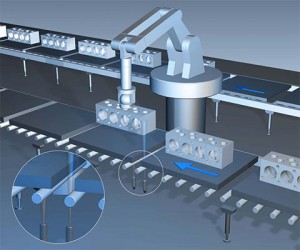Sensors position workplace carriers on conveyor
 An automotive manufacturer is relying extensively on the reliability of Contrinex’s robust and high-performance inductive sensors in the automated assembly of engines, where cylinder heads are transferred for mounting on the engine.
An automotive manufacturer is relying extensively on the reliability of Contrinex’s robust and high-performance inductive sensors in the automated assembly of engines, where cylinder heads are transferred for mounting on the engine.
The assembly of an engine requires cylinder heads to be transferred from one conveyor line to another. At the transfer station, sensors under the roller conveyor detect the arrival of the workpiece carrier and pause the conveyor to position the carrier and cylinder head in place for an industrial robot to unload it.
The robot lifts the cylinder head off the workpiece carrier and transfers it to a new one on an adjacent assembly line. Once the cylinder head has been removed from the carrier, the sensor triggers the roller conveyor is OK to start up to position the next cylinder head assembly and return the empty carrier to the loading station.
The safe and efficient operation of the transfer process is ensured by the automation of the roller conveyor stop and restart using the position checking of the cylinder heads.
Inductive sensors from Contrinex’s 700 Series Extreme family are used due to their robust construction and proven reliability. Just three DW-AS-713-M30 compact inductive proximity sensors, with a 40mm sensing range are used to ensure the safe, reliable implementation of this task.
The robustness and reliability of these sensors is typically demonstrated by Contrinex showing them survive being used to hammer nails into a block of wood, and this robustness makes them ideal for surviving accidental impacts in a congested factory.
The sensors are mounted between the conveyor’s rollers at the transfer station so that when an incoming workpiece carrier covers the second sensor, it is in the correct position. The roller conveyor is therefore instantly stopped and the industrial robot starts the transfer process.
Once the robot advises that the cylinder head has been removed, the third sensor ensures that the empty workpiece carrier takes the correct onward path.
The accuracy in switching distance of these sensors is trusted to ensure that a stop is initiated at exactly the right moment. This helps ensure that the lift and transfer process takes place under the safest possible conditions while maintaining all the speed and consistency expected from an automated factory process.
By stopping and restarting the roller conveyor at exactly the right moment and checking the workpiece position, automated transfer stations speed up production and minimise wastage, downtime and damage to equipment.
Visit the Plus Automation website for more information
See all stories for Plus Automation















